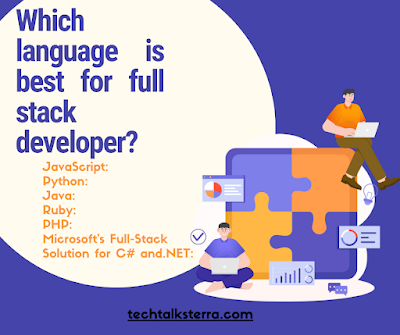Introduction:
The position of a full-stack developer has grown in
importance in the quickly changing web development industry. Being skilled in
both front-end and back-end technologies, a full-stack developer can manage the
entire development process with ease. Choosing the appropriate programming
language for a stack is one of the most important choices that aspiring
full-stack developers must make. This post will discuss several languages that
are frequently used in full-stack development as well as things to think about
before making this important choice.
1. 1. JavaScript: The Web's Language
With its foundation in full-stack development, JavaScript
powers both front-end and back-end frameworks. React.js, Angular, and Vue.js
are just a few of the front-end libraries that offer reliable ways to create
dynamic user interfaces. Node.js and Express.js are now the most popular
back-end frameworks for creating scalable and effective server-side
applications. JavaScript is a great option for full-stack developers because of
its versatility, which allows them to work fluidly across the entire stack.
2. 2. Python: A Versatile and Simplicity Language
Python is a favorite among developers because of its
simplicity and ease of reading. Popular Python frameworks for back-end
development, Django and Flask, offer strong tools for rapidly creating web
applications. With frameworks like Flask's integration with multiple front-end
libraries and Django's templating engine, Python's elegance also extends to the
front end. The language is a desirable choice for full-stack development due to
its adaptability, simplicity of learning, and strong community support.
3. 3. Java: Enterprise Solutions' Powerhouse:
Platform independence and scalability make Java a popular
option for full-stack development at the enterprise level. Spring Boot and
JavaServer Faces (JSF) are popular tools for building reliable and dynamic
online applications. Java is a preferred language for businesses needing
stability and performance in their applications because of its strength in
managing intricate and large-scale projects.
4. 4. Ruby: A Language Designed to Make
Developers Happy:
Ruby is the base language of the Ruby on Rails framework,
known for its elegant syntax and emphasis on developer satisfaction. Ruby on
Rails is well known for its convention over configuration principle, which
enables programmers to write less code when creating web applications. Ruby is
a great option for startups and small to medium-sized projects because of its
readability and the speed at which applications can be developed, according to
full-stack developers who use it.
5. 5. PHP: The Leader of the LAMP Stack:
PHP has been a reliable option for full-stack development
and has long been linked to the LAMP (Linux, Apache, MySQL, PHP) stack. The PHP
framework Laravel offers a feature-rich syntax and a multitude of tools for
developing contemporary web applications. Because PHP is easy to integrate and
works with a variety of databases and web servers, it's a good choice for
developers who want to create dynamic and scalable web applications.
6. 6. Microsoft's Full-Stack Solution for C#
and.NET:
For full-stack development, C# and the.NET framework work
well together, especially inside the Microsoft ecosystem. On the back end,
developers can design dependable and safe web applications with ASP.NET.
Because of its robust typing and object-oriented features, C# is a popular
choice for enterprise-level applications and large-scale projects. Development
efficiency is increased by the.NET ecosystem's smooth integration of front-end
and back-end components.
Things to Take Into Account While Selecting a Language:
Project prerequisites:
Take into account the particular requirements of your
project, including performance, scalability, and industry standards.
Experience as a
Developer:
Assess the development team's level of comfort and
proficiency with a specific language.
Community Assistance:
Evaluate the size and activity of the language-related
community, since sharing knowledge and solving problems is facilitated by a
strong community.
Libraries and
Ecosystems:
Look into the tools, libraries, and frameworks that are
available to make development in the language of your choice easier.
Scalability:
Think about how scalable the language is for both modest projects and possible future additions.
Selecting the best programming language for full-stack development
is a multifaceted decision. Each of JavaScript, Python, Java, Ruby, PHP, and C#
has advantages over the others. In the end, a full-stack developer should use
the language that best fits the needs of the project, the team's experience,
and the organization's objectives. Comprehending current industry trends,
experimenting with various languages, and adjusting to emerging technologies
are essential skills for full-stack developers to effectively navigate the
ever-changing web development landscape.








